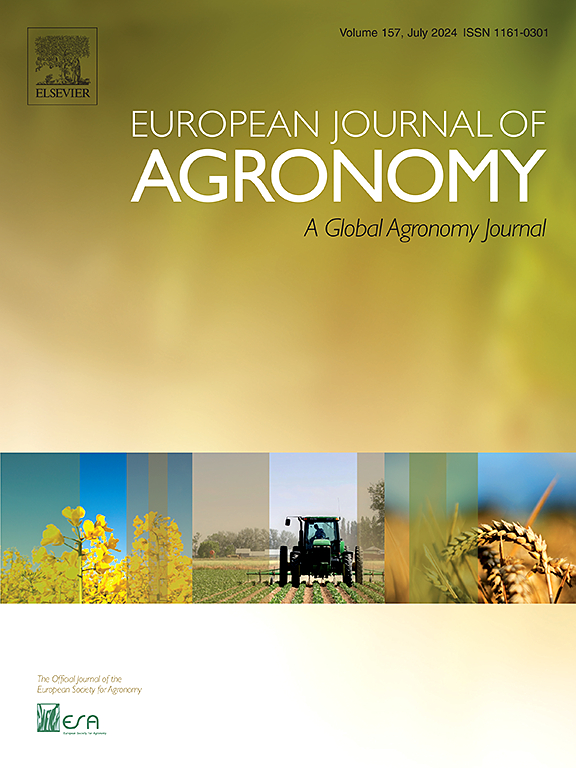Direct measurements unveil overestimations in nitrous oxide emissions from legume-based strip intercropping
IF 4.5
1区 农林科学
Q1 AGRONOMY
引用次数: 0
Abstract
Accurate evaluation of greenhouse gas (GHG) emissions from legume-based intercropping is key to supporting the agricultural green transition. However, current methods often ignore the direct emissions from the interspecific interaction row of legume/cereal intercropping. Here, a two-year field experiment was conducted to evaluate the difference between direct measurement and theoretical estimation of N2O emissions and soil respiration from maize/peanut and maize/soybean strip intercropping. Results showed that theoretical estimation overestimated the N2O emissions from interaction row by 12 – 15 % compared to direct measurement (P < 0.05). This overestimation occurred mainly during the N2O emissions peak (lasting 5 – 7 days) after topdressing N fertilization, which accounted for 21 – 49 % of the overestimation. Soil NH4+ and NO3- concentrations in the interaction row were 33 – 129 % and 26 – 96 % lower than the weighted average of the crop rows following topdressing N fertilization (P < 0.05). However, the soil respiration of the interaction row did not differ between direct measurement and theoretical estimation, which may indicate N is the key interaction elements for intercropped legume and cereal rather than carbon. Furthermore, the uncertainty in theoretical estimation of N2O emissions from legume-based intercropping was increases with the decrease of strip width, which mainly due to the increasing contribution of interaction zone. In conclusion, theoretical estimation can lead to an overestimation of N2O emissions, underscoring the necessity for direct measurement, especially as strip width narrows with increased proportion of interspecific interactions zones.
直接测量揭示了对豆科作物带状间作的氧化亚氮排放的高估
准确评估豆科作物间作的温室气体排放是支持农业绿色转型的关键。然而,目前的方法往往忽略了豆科/谷类间作种间互作行的直接排放。通过为期2年的田间试验,比较了玉米/花生间作和玉米/大豆间作N2O排放和土壤呼吸的直接测量值与理论估算值的差异。结果表明,与直接测量相比,理论估算高估了相互作用排N2O排放量12 - 15 % (P <; 0.05)。这种高估主要发生在追肥后N2O排放高峰期(持续5 ~ 7 d),占高估量的21 ~ 49% %。互作行土壤NH4+和NO3-浓度分别比追肥后作物行加权平均值低33 ~ 129 %和26 ~ 96 % (P <; 0.05)。然而,交互行土壤呼吸在直接测量值和理论估算值之间没有差异,这可能表明氮素是间作豆类和谷物的关键交互元素,而不是碳。豆科作物间作N2O排放理论估算的不确定性随着带宽的减小而增大,这主要是由于相互作用带的贡献增大所致。综上所述,理论估算可能导致对N2O排放量的高估,强调了直接测量的必要性,特别是随着种间相互作用区比例的增加,条带宽度变窄。
本文章由计算机程序翻译,如有差异,请以英文原文为准。
求助全文
约1分钟内获得全文
求助全文
来源期刊

European Journal of Agronomy
农林科学-农艺学
CiteScore
8.30
自引率
7.70%
发文量
187
审稿时长
4.5 months
期刊介绍:
The European Journal of Agronomy, the official journal of the European Society for Agronomy, publishes original research papers reporting experimental and theoretical contributions to field-based agronomy and crop science. The journal will consider research at the field level for agricultural, horticultural and tree crops, that uses comprehensive and explanatory approaches. The EJA covers the following topics:
crop physiology
crop production and management including irrigation, fertilization and soil management
agroclimatology and modelling
plant-soil relationships
crop quality and post-harvest physiology
farming and cropping systems
agroecosystems and the environment
crop-weed interactions and management
organic farming
horticultural crops
papers from the European Society for Agronomy bi-annual meetings
In determining the suitability of submitted articles for publication, particular scrutiny is placed on the degree of novelty and significance of the research and the extent to which it adds to existing knowledge in agronomy.
 求助内容:
求助内容: 应助结果提醒方式:
应助结果提醒方式:


